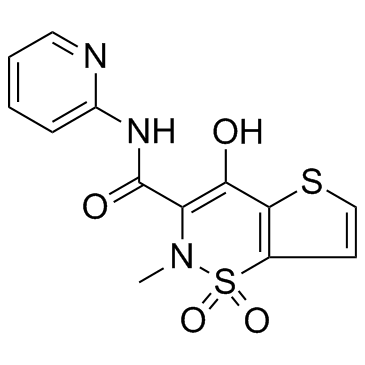Tenoxicam

Tenoxicam structure
|
Common Name | Tenoxicam | ||
|---|---|---|---|---|
| CAS Number | 59804-37-4 | Molecular Weight | 337.374 | |
| Density | 1.7±0.1 g/cm3 | Boiling Point | N/A | |
| Molecular Formula | C13H11N3O4S2 | Melting Point | 209-2130ºC | |
| MSDS | Chinese USA | Flash Point | N/A | |
| Symbol |

GHS06 |
Signal Word | Danger | |
|
Semi solid matrix formulations of meloxicam and tenoxicam: an in vitro and in vivo evaluation.
Arch. Pharm. Res. 38 , 801-12, (2015) The objective of this study was to improve the dissolution and subsequently the therapeutic efficacy of poorly water soluble BCS class-II drugs meloxicam and tenoxicam, by lipid semi solid matrix (SSM) systems filled in hard gelatin capsules by liquid fill te... |
|
|
[Turbidimetric determination of tenoxicam using molybdophosphoric acid].
Rev. Med. Chir. Soc. Med. Nat. Iasi. 114(1) , 249-54, (2010) A turbidimetric method was developed for tenoxicam quantification using the complexing reaction with molybdophosphoric acid in hydrochloric acid medium; the complex has a maximum of absorbance at 369 nm.The practical working conditions were established. In th... |
|
|
Effect of age on the pharmacokinetics of tenoxicam in comparison to other non-steroidal anti-inflammatory drugs (NSAIDs).
Scand. J. Rheumatol. Suppl. 80 , 86-9, (1989) Investigations have shown that elderly patients have an increased sensitivity to the effects of non-steroidal anti-inflammatory drugs (NSAIDs) with a concomitant higher frequency of side-effects. Several explanations for such an observation are possible inclu... |
|
|
Determination of pKavalues of tenoxicam from1H NMR chemical shifts and of oxicams from electrophoretic mobilities (CZE) with the aid of programs SQUAD and HYPNMR
Talanta 80(2) , 754-62, (2009) In this work it is explained, by the first time, the application of programs SQUAD and HYPNMR to refine equilibrium constant values through the fit of electrophoretic mobilities determined by capillary zone electrophoresis experiments, due to the mathematical... |
|
|
Comparing the efficacy of intravenous tenoxicam, lornoxicam, and dexketoprofen trometamol for the treatment of renal colic.
Am. J. Emerg. Med. 30(8) , 1486-90, (2012) The aim of this study was to compare the efficacy and safety of 3 nonsteroidal anti-inflammatory drugs-intravenous tenoxicam, lornoxicam, and dexketoprofen trometamol-for the treatment of patients with renal colic.We conducted a prospective double-blind rando... |
|
|
The efficacy of paracetamol versus tenoxicam on postoperative pain and morphine consumption after abdominal hysterectomy: a placebo-controlled, randomized study.
Clin. Exp. Obstet. Gynecol. 39(1) , 49-52, (2012) The purpose of this study was to determine the analgesic efficacy and side-effects of paracetamol and tenoxicam in comparison with placebo in patients with postoperative pain after elective abdominal hysterectomy.A total of 120 patients were randomly divided ... |
|
|
Tenoxicam-associated hepatic injury: a case report and review.
Eur. J. Gastroenterol. Hepatol. 9(4) , 403-6, (1997) A 51-year-old woman developed jaundice while taking tenoxicam. A full evaluation, including ultrasound, computed tomography, endoscopic cholangiography and liver biopsy, confirmed the diagnosis of mixed hepatic injury. The patient's jaundice and all other liv... |
|
|
Effect of tenoxicam on rat liver tissue.
Turk. J. Gastroenterol. 21(2) , 146-52, (2010) Tenoxicam is a non-steroidal antiinflammatory drug, which has antipyretic and antiinflammatory effects. Though it is known that the major side effect of non-steroidal antiinflammatory drugs is on the gastrointestinal tract and liver, there have been few studi... |
|
|
Efficacy and tolerability of tenoxicam--an overview.
Scand. J. Rheumatol. Suppl. 65 , 107-12, (1987) One-hundred and thirty-three clinical studies have been conducted with tenoxicam in patients with rheumatoid arthritis, osteoarthrosis, extra-articular rheumatism, ankylosing spondylitis and acute gouty arthritis. Its efficacy has been demonstrated in double-... |
|
|
Determination of pKa values of nonsteroidal antiinflammatory drug-oxicams by RP-HPLC and their analysis in pharmaceutical dosage forms.
J. Sep. Sci. 32(17) , 2928-36, (2009) In this study, pK(a) values were determined by using the dependence of the capacity factor on the pH of the mobile phase for four ionizable substances, namely, tenoxicam, piroxicam, meloxicam, and naproxen (I.S.). The effect of the mobile phase composition on... |